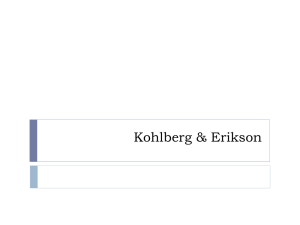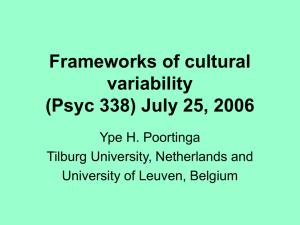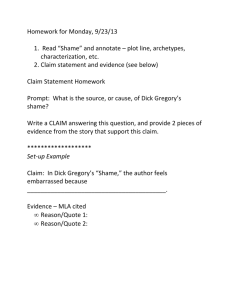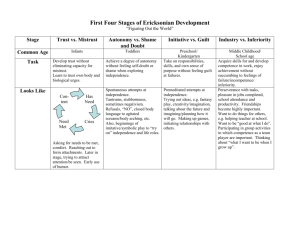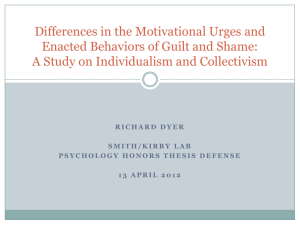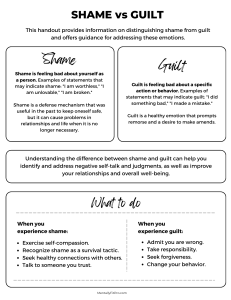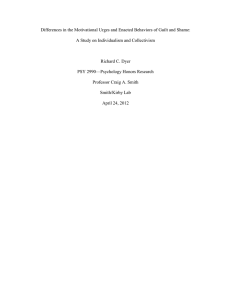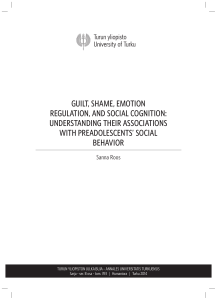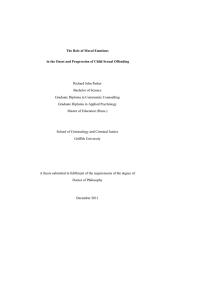Asking Why, Not Who? Why Lean Management Needs a
advertisement
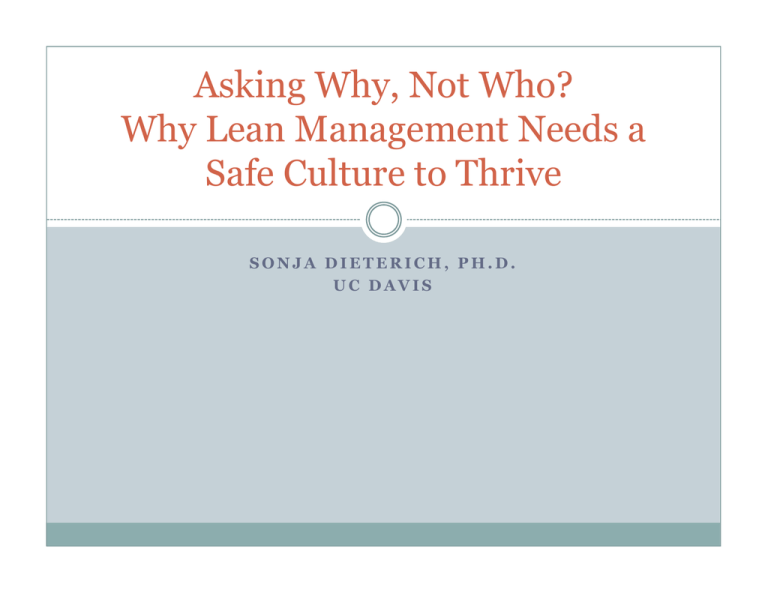
Asking Why, Not Who? Why Lean Management Needs a Safe Culture to Thrive SONJA DIETERICH, PH.D. UC DAVIS Two Stories of Safe Culture I have worked for 10 different employers … Story 1: The intoxicated senior employee Story 2: Reporting a communication problem Requirements for Lean: “Go to the Gemba (Shop Floor)”: will you be shown the pretty picture or entrusted with issues that need to be solved? Are process variation measurements accurate? Remember what happened at the Arizona VA with measuring time to first appointment?! Staff needs to engage to suggest improvements “We do our LEAN projects to get our bonuses, and then we get to our real work.” “We have one FTE dedicated to just do the LEAN projects.” Common Theme: Trust ASSURED RELIANCE ON THE CHARACTER, ABILITY, STRENGTH, OR TRUTH OF SOMEONE OR SOMETHING Trust = Safety “Physician leaders must encourage a systematic effort to assess existing processes and must promote an open and just environment in which all team members are free, and responsible, to raise concerns about safety.” Thinking back to my stories The intoxicated senior employee: Leader knew serious issues would be brought to attention Senior employee got needed help; returned to work contributing significant skills I gained trust to bring up even difficult issues Coworkers observing … what did they learn? Created safer environment Reporting a communication problem: Was I as willing to bring up further improvement suggestions? Better not get in the middle of things … Impact on safe work environment? Why? vs. Who? Story 1: Why was there a problem? Intoxication Story 1: Who was the problem? Neither me (reporter) nor senior employee (reported) Story 1: Solution was to get the senior employee help. Story 2: Why was there a problem? Communication (so I thought) Story 2: Who was the problem? Coworker failed to communicate I brought up the issue to my boss Story 2: “Solution” ? Why do we ask “Who?” first? What were we taught? “We have a safe culture in our clinic. Whoever makes a mistake gets fired.” - Anonymous Question: Who was raised in a house-hold with blame culture? Diagnostics: When something goes wrong, do you get angry at the person for screwing it up? Focusing on “Who”: He/she is …sloppy, not paying attention/not a good xyz/… “Why” vs. “Who” = Guilt vs. Shame Understanding the difference between guilt and shame Example: I am guilty of overlooking a discrepancy in energies between prescription and plan. I am ashamed to be an inattentive physicist. Guilt refers to an action or behavior (”Why”). Shame relates to how you think of yourself as a person (“Who”). Safety Culture in the Context of Guilt vs. Shame Shame raises the bar to improve: It is hard/impossible to change who we are Guilt is conducive to improvement: When we fail at a task, we know we must practice to improve our skills Watching our language: guilt or shame? “You missed this error” vs. “You are inattentive” “Why did you miss?” vs. “Pay more attention!” Root cause analysis vs. personal pressure Work out Solution vs. Business as Usual Obstacles to asking “Why?” External Obstacles “I have a safe culture in my clinic. Whoever makes a mistake gets fired.” - Anonymous Chairman, MD We cannot control others. The stakes are high. The Optimist’s Approach Culture can change. Behavioral research on how to change culture: Appeal to values. E.g. Chairman Anonymous may value honesty Conversation about how to foster honesty Simplistic example … but worth some thought & effort If nothing helps, Option 1 Anonymous Chairman, MD turns out to be an immovable object on Safe Culture Option 1: Work inside your sphere of influence You cannot control others You can build a sphere of trust in coworker’s relationship to you Outside of your control Your Sphere of Influence Book Recommendation If nothing helps, Option 2 Anonymous Chairman, MD turns out to be an immovable object on Safe Culture Option 2: Leave (if you can). Impact on your self-motivation to practice safely Quality of patient care? Spending your skills and time in an inherently unsafe place (even if nothing has happened yet) Effects on your career/reputation if something happens (e.g. imagine having been one of the physicists of the NYT events. They likely were good people with solid skills in a bad environment) The Stakes of Staying with “Who?” not “Why” Another story A near-miss with possible lethal consequences was discovered by RTTs minutes before first treatment. Who missed the error: Dosimetrist Physician signing the plan 2nd physics check Patient-specific QA ALL participants were competent people except … One of them was a “difficult personality”. Guess WHO took the blame? Error never reported to vendor. Don’t know if error was reported to internal incident learning system. No RO-ILS (yet). Years later… I learn in a society committee meeting of 10 people that there was 1 incident and at least one other nearmiss that sounded eerily familiar… Consequence of “Who?” not “Why?” Could the incidence at another site have been prevented if we had been more persistent in asking “Why” instead of focusing on “Who?” based on existing prejudice? Did the error ever get reported to the vendor and resolved (if it was a vendor issue?)? Is there still a risk out there? What if the Therac-25 incidents had focused on “Who?”?! http://sunnyday.mit.edu/papers/therac.pdf Summary The “soft” side of Safe Culture forms the basis for implementing successful Lean Culture/Processes Safe Culture focuses on actions, not people Safe Culture sets the conditions for solving problems Implementation of Safe Culture must come from leadership “Influence without Authority” works! (most of the time)

